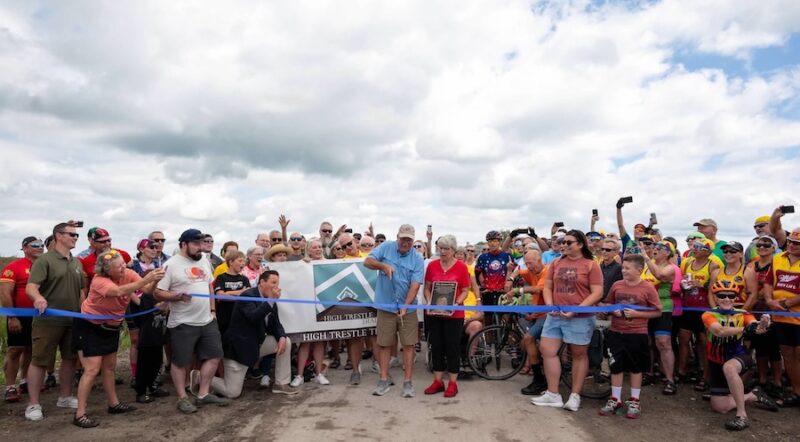Exploring America’s E-Bike Evolution

“Now it’s younger families, maybe zero-car families that are using cargo e-bikes as a car replacement, or commuters trying to get from A to B in the most efficient way they can.”
—Noel Kegel, Co-Owner, Wheel & Sprocket, on the changing demographics of e-bike users
In June, Dianne Iverson and Paul Dutky will lead their bike club on a multiday 400-mile ride across Washington’s Cascade Mountains. It’s a challenging trek, and one that this group of riders in their 70s is embracing with enthusiasm. “E-bikes will help make it happen,” explained Iverson.
Married during the height of the COVID pandemic in 2020, Iverson and Dutky have the easy rapport of a couple married for far longer. They’re avid cyclists who regularly log 50+ miles in an outing and recently took a road trip around the American Southwest, where they racked up hundreds of miles in and around multiple national parks.
An already impressive cycling résumé is made all the more so by the fact that Iverson is missing both legs below her knees. Fitted with prosthetics to replace the limbs lost to cancer, Iverson and her husband Dutky can often be found on a type of tandem bike rarely seen in this country (though more common across Europe) that places the captain in a standard upright stance behind the stoker, who sits up front in a recumbent position.

Riding around the Puget Sound region, the duo is “better than a bunch of puppy dogs at drawing attention,” Iverson quipped. “We’re just a magnet for discussion whenever we slow down.” The couple augment their pedal power with an electric motor they retrofitted onto their tandem just three years ago, around the same time that “practically our entire bike club either modified their existing bikes with e-assist or bought a new e-bike,” Iverson said.
“For people our age, it’s definitely extended the amount of time we can ride and where we go; we live in a very hilly county, and this bike allows us to go over mountain passes,” said Iverson.
“You’re still working,” Dutky added, “but with the motor, we don’t have to worry about the hills; we can explore almost anything without hesitation.”
Put simply, said Iverson: “It’s freedom for us.”
It’s a dynamic that Noel Kegel, a board member for Rails-to-Trails Conservancy and an owner of Wheel & Sprocket—a chain of 12 bike shops in Wisconsin and Illinois—is very familiar with. Kegel says he has seen explosive growth in the number of e-bikes sold to older customers.
And while an older demographic originally led early e-bike adoption, with somewhere around 80% of his e-bike customers being retirees, Kegel said that it’s “sort of changing—now it’s younger families, maybe zero-car families that are using cargo e-bikes as a car replacement, or commuters trying to get from A to B in the most efficient way they can.” With urban congestion being the norm most hours of the day in many cities—including Milwaukee and Chicago, where Kegel spends much of his time—he observed that “e-bike trips can easily be faster than driving or taking the bus.”
So What Is an E-bike?

At their heart, electric bikes—generally shortened to e-bikes or e-assist bikes—are otherwise traditional bikes and trikes that utilize a small battery-powered motor to augment a cyclist’s pedaling efforts. There is also a class of e-bike that can be activated solely by a throttle. Commonly sold e-bike motors generally output between 250 and 750 watts (or between a third and a full horsepower).
The electric assist is typically used by riders to keep up their pace over distances or up inclines. Despite the performance boost, Kegel said that riding an e-bike “is a very intuitive experience. It’s just like riding a [traditional] bike, but it makes you feel stronger than you actually are—you feel like Superman.”
It might be that superhero ability that creates concerns for some users of multiuse trails or gives rise to the idea that an e-bike differs from a motorcycle only in name.
As e-bikes have risen in popularity—extending access to trails and bicycling for many—their increased presence, during a time when trail policies and recommendations are in their infancy or vary at the local, state and national levels, has also led to questions around their use and, at times, negative perceptions.
A cyclist and e-bike activist in Palo Alto, California, Paul Trainer has been riding e-bikes since long before they were commercially available and takes issue with the motorcycle comparison. “I built my first e-bike when I was in high school; this was in like 1969,” he said. “They’ve been a part of my life forever.” Trainer’s first home-built e-bike was powered by lead-acid batteries carried in modified saddlebags—the same bulky, heavy batteries that have powered the starter motor of automobiles for decades.
While today’s refined e-bikes have much better batteries and more powerful motors, “they are still essentially bicycles,” argued Trainer. “They’re still made out of bicycle parts.” Trainer is adamant that comparing a motorcycle even to those types of e-bikes that move with just the push of the throttle misses the mark. E-bikes are very nearly silent and emit no exhaust; trying to compare a single-horsepower electric bike to a motorcycle that outputs 100-plus horsepower, Trainer said, is a false equivalency.
And it’s not just a philosophical distinction, said Dr. Ash Lovell, the electric policy and campaign director of PeopleForBikes, the bicycle industry’s trade association. Her organization developed the three-class system of categorizing e-bikes [see sidebar on e-bike classes] that has so far been codified into law by 40 states. “Anything that goes faster than 20 miles an hour with throttle power is just not an electric bike under the definition,” she said. But legal definitions aside, Lovell noted that “technology always wants to get ahead of regulation” and pointed to increasing numbers of direct-to-consumer products that are pushing the limits of the definition of an e-bike in terms of their size and speed—going outside the bounds of the classifications that are becoming a universal guide for understanding the technology.
E-Bike Classes
Class 1: E-bikes are pedal-assist models with motors that work only while the rider is pedaling. They have a top speed of 20 mph, at which point the motor automatically disengages. While riders can go faster, any speeds above 20 mph are courtesy solely of the rider’s muscle power.
Class 2: E-bikes have a throttle, allowing the motor to power the bike even without the rider pedaling. The motor stops providing assistance at speeds in excess of 20 mph.
Class 3: E-bikes are the most powerful; again pedal-assisted, these bikes can reach 28 mph before the motor stops providing power.
Typically, when e-bikes are allowed on multiuse trails, they have been Class 1 and 2, and subject to the same rules and regulations that govern other cyclists.
Electric Popularity

“We have people coming into the shop who say, ‘If it wasn’t for [e-bikes], I wouldn’t be getting outside and exercising at all.’”
—Stan Boyer, Kyle’s Bikes
Regardless of what classification tier they fall into, e-bikes are the fastest-growing segment in the bike industry and, for several years now, have even outpaced electric vehicles in terms of units sold, said Lovell.
Lovell noted that the speedy adoption of e-bikes over the past decade can be attributed in large measure simply to the joy they bring to riding, but also because they “reduce a lot of barriers for people to get on their bike at all. Maybe you’re … not as physically fit as you once were, but you still want to get out and ride,” she said.
Upon their retirement, Stan and Roz Boyer started working part-time at Kyle’s Bikes in Waukee, Iowa, where they say that they, too, have seen a stratospheric interest in e-bikes. “I can’t tell you as far as a percentage of sales,” said Stan, “but just from riding around our [RTC Hall of Famer Raccoon River Valley Trail], I know there are probably two or three times as many e-bikes as there were just four or five years ago.”
“We have people coming into the shop who say, ‘If it wasn’t for [e-bikes], I wouldn’t be getting outside and exercising at all,’” he added.
Surrounded by customers embracing e-bikes, Roz saw their benefits and purchased one for herself, but Stan has been a holdout. Approaching 68 years old, Stan is paraplegic and rides a hand-cycle. “I just don’t know how much longer my shoulders can do what I want to do,” he conceded, but despite being perhaps the poster child for e-bikers, Stan said he had personal reservations about letting a motor do any part of the biking work. “I guess I’m a purist at heart.”
While both Boyers say they have seen firsthand the benefits of e-bikes—from an 87-year-old customer extending his riding years, to adaptive trike riders using the boost to get where they couldn’t otherwise go—they also expressed varied reservations about throttle-controlled e-bikes.
Stan used to feel that only bikes requiring pedaling input should be allowed; however, his wife’s recent knee replacement had him rethinking that stance. “I am still concerned people will abuse the throttle,” he said, but now believes “there is a place for throttle-assist bikes.”
Roz said she is concerned by e-bike riders who go faster than trail etiquette demands; not only do they put themselves and others at greater risk in the event of a collision, she said, but their actions could increase the appetite of trail managers or legislators to impose artificially low speed limits on trails. “That would put a lot of serious riders,” whether on e-bikes or not, “out onto the roads competing with traffic,” she said.
Related: National E-Bikes Guidance | Trail-Building Toolbox
But What’s It Gonna Cost?
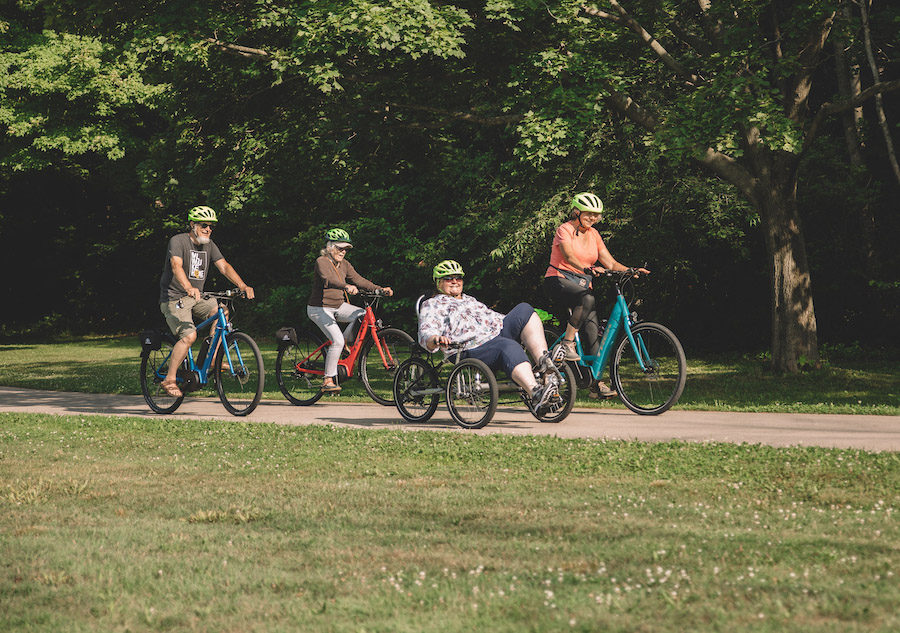
There’s no doubt that electric bikes cost more than their acoustic counterparts, said Larry Pizzi, the general manager of Alta Cycling Group, the parent company of such brands as Diamondback and IZip. Depending on the components equipped, “Quality e-bikes are generally four or five times more expensive, and that’s prohibitive for a lot of people,” he said. “Evaluated based on what they can save from other forms of transportation, it may be justifiable—but the initial expense is hard to overcome.”
Of course, the expenses don’t end with the purchase: Pizzi noted that e-bikes have the same maintenance costs as unpowered bikes—consumable components such as tires, tubes and brakes—but the increased 15–20 pounds that an e-bike brings means they all wear out a little faster. “Component manufacturers have started making more durable parts that are e-bike-specific,” he said, “but premium parts only add to the cost of the bike.”
And that’s not to mention the expensive consumable at the heart of every e-bike. A battery has a limited number of charge-discharge cycles it can undergo before its capacity becomes noticeably diminished. “A premium brand will last somewhere between 800 and 1,000 full recharge cycles,” Pizzi said, which correlates to about four to five years of consistent use, though he noted that less frequent usage and shallower discharges will extend the life of the battery.
While Pizzi is fully cognizant of the downsides of e-bikes, he’s nonetheless a full-throated advocate for them. “I was on Capitol Hill just last week lobbying for [the E-BIKE Act],” Pizzi said. After failing to pass last year, the E-BIKE Act was recently reintroduced in the U.S. House of Representatives; the bill authorizes a tax credit that would effectively knock 30% off the cost of a new e-bike. “From our perspective, it makes a tremendous amount of sense.”
Not every cost has a dollar sign in front of it, though. There are significant environmental impacts that come from mining and refining the materials central to modern batteries, and the battery’s innards again become an issue once it reaches the end of its useful life. “A lot of the focus is on the metals—the lithium, the nickel, the cobalt—in part because those are the more costly components,” said Dr. Eric Dufek, a battery researcher at the Idaho National Laboratory, a Department of Energy facility. Dufek knows batteries. He puts his background in electrochemistry to use as the head of a team of some 45 researchers working on advanced battery technologies.
“[These modern batteries are also] the ones that have the greatest environmental impact,” he added. “It’s really important to think about how we recycle; we need to get old batteries into the recycling chain.”
Noting that lithium is a finite resource, Lovell of PeopleForBikes echoed the importance of recycling batteries, saying, “They cannot just go into the landfill—they’re hazardous waste.” To this end, she explained that PeopleForBikes and their members have created an e-bike battery recycling program. “It’s actually the first of its kind in the transportation sector,” Lovell explained. “The bicycle industry wanted to get ahead of this issue; we beat the auto industry, and we’re pretty proud of that.”
880,000
Estimated no. of e-bikes purchased in 2021—outnumbering electric vehicles sold
338%
Increase in average daily distance biked by e-bike users according to a study
A Patchwork Quilt of Regulations
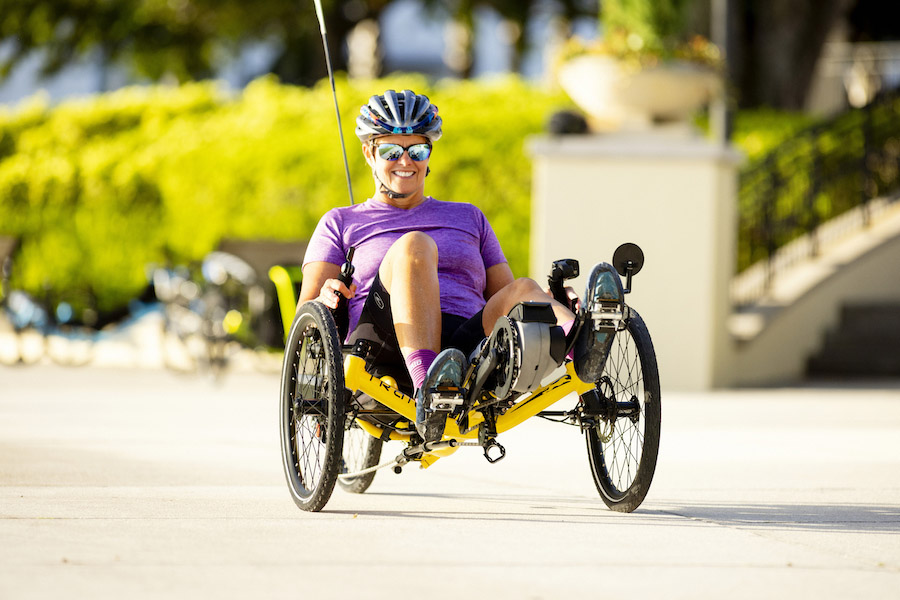
Caps on speed, limitations on certain types of e-bikes and outright bans are all part of the patchwork of rules defining what e-bikes are and where they can go.
Take Palo Alto, California: Earlier this year, the city council voted to restrict e-bike usage on unpaved trails within the city’s nature preserves. The decision closed off much of the Baylands—a 1,940-acre area home to innumerable migratory shorebirds and other wildlife that’s considered one of the best bird-watching spots on the West Coast—to all cyclists who can’t pedal through the area entirely under their own power.
“I think the argument against [e-bikes] was essentially that they are presumed to go a certain speed and that traveling at that speed is potentially threatening to wildlife,” said Julie Lythcott-Haims, a city council member who voted against the ban. “I think there was also a sense that humans are also disturbed by e-bikes.”
But none of the given objections to e-bikes could convince her to vote in favor of the ban. Echoing a sentiment offered by other council members, she stated, “We should regulate the behavior, not the device. E-bikes have brought mobility to many, many residents and visitors who otherwise wouldn’t be able to be out there on the Baylands.”
A thousand miles away, Luke Svare also sees the effects of patchwork regulations. One of the state’s four trail coordinators for Colorado Parks and Wildlife, he said one of the biggest challenges with managing e-bike use is that “it’s hard for the user to know what the regulations are on this chunk of dirt that they’re on. Trail systems are connected from one jurisdiction to another, and you could travel from state land to county land to federal land and not know it. When you’re crossing those boundaries, the regulations could change drastically.”
Without consistent, unifying rules regarding e-bike usage, Svare suggests that riders familiarize themselves with the regulations in place before setting out.
Rails-to-Trails Conservancy (RTC) has also grappled with how e-bikes are treated in relation to trail use and has created a comprehensive framework discussing their legal status at the state and national levels. RTC’s vice president of policy, Kevin Mills, explained that by law, motorized vehicles are not allowed on many trails, so when e-bikes came along, “The question became, ‘Wait … is this motorized?’”
In the absence of guidance, Mills continued, “you’d have some trail managers determining, ‘Well, I guess there’s a little motor in there, so by definition it must be motorized, and you’d have others saying, ‘This looks and acts like a bicycle except that little battery pack—so what’s the problem?’”
It came down to a distinction between the letter of the law (e-bikes technically have a motor and are therefore motorized vehicles) and the spirit of the law (prohibiting noisy, larger, polluting, fast-moving internal combustion machines from multiuse trails).
In the end, said Mills, allowing lower-speed e-bikes, even on those trails that otherwise prohibit motorized vehicles, “seems legitimate; it’s not about the engineering—it’s about the actual policy goals of ensuring that trails are safe, healthy and pleasant for all users.”
Does My Trail Permit E-Bikes?
To determine if a particular trail permits e-bikes or a certain class of e-bikes, it’s best to consult the trail manager. For contact and website info, go to TrailLink.com™, which catalogues information for more than 40,000 miles of multiuse trails across the United States.
Learn more about e-bikes and trail use, including current policies, rules and regulations on RTC’s website.
Powering the Evolution

While electric bikes have a surprisingly long history—the first U.S. patent on an electric bicycle was granted in 1895!—what held them back for so long was largely their power source. Neither the lead-acid batteries that Trainer once used in his home-built machines, nor the parade of battery technologies that followed, stored enough energy in a small enough package to be a viable option.
Enter the lithium-ion battery. After some 30 years of development, lithium-ion batteries moved out of the laboratory and into consumers’ hands in the early 1990s, and advances since then have been astounding. “It’s been about a three- to fourfold improvement in energy density since those first commercialized lithium-ion batteries,” said Dufek, “and in that same time, their cost has fallen up to tenfold.”
The rise of e-bikes, said Dufek, has coincided with the rise of electric vehicles in a virtuous cycle in which “the batteries being developed for electric vehicles cascade fairly well over to e-bikes; the advances in [battery] chemistry map to both uses.” And while he’s optimistic about additional refinements in lithium-ion batteries, he doesn’t foresee the same kind of exponential advances that the past 30 years have brought. He anticipates perhaps another doubling in energy density, but the main area of research, he said, is now largely focused on improving charging speeds.
Burning Questions
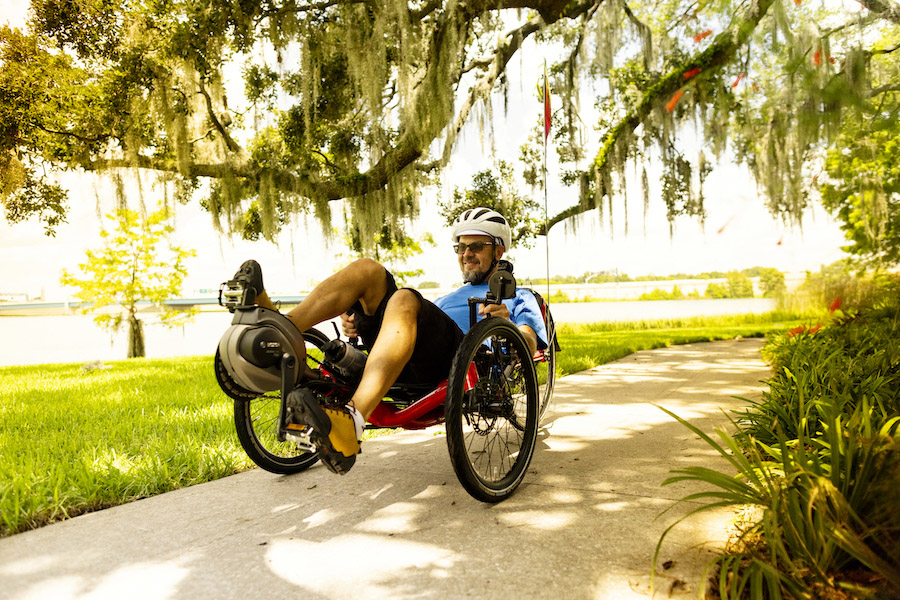
It’s impossible to talk about the rise in e-bike popularity without discussing the devastating battery fires that occasionally make headlines. Dr. K.M. Abraham has been involved with lithium-ion battery research since its infancy; a retired professor from Boston’s Northeastern University and now a battery industry consultant, he said that consumers have little to fear from quality batteries purchased from reputable companies.
The same lithium-ion technology used to power e-bikes is used “in billions of cell phones and laptops around the world every day, and all these batteries have to undergo safety tests and meet certain standards,” Abraham said.
While anything manufactured in vast quantities will have occasional manufacturing defects, Abraham offered that “the problems come from replacement batteries that are poorly made and lack a UL certification”—the imprimatur of Underwriter Laboratories that assures certain safety standards have been met.
Most headline-grabbing fires are the result of substandard off-market batteries that appeal to consumers looking to either save some money or get more energy from their power packs. The batteries might be made without industry-standard safety measures, allowing them to be less expensive. Or, unable to cheat physics, disreputable manufacturers instead cheat safety protocols, packing more energy capacity into batteries at the expense of safety mechanisms that keep batteries from catching fire.
It’s easy enough to protect oneself against these dangers, though, said Abraham. Look for the UL symbol on the product or packaging, and “buy batteries from reputable manufacturers. Use the charger designated for that particular battery, and use the battery according to the instructions. It will be a little more expensive, but then you know the battery will be safer.”
Slow Down—You Move Too Fast
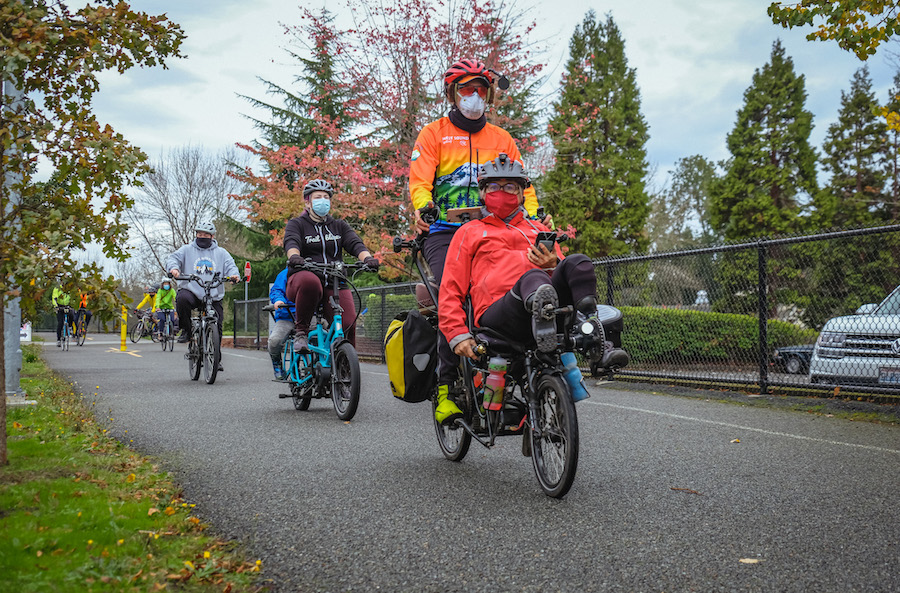
Claire Martini is the project manager for the Leafline Trails Coalition of Washington State, where she works with multiple organizations to knit together the region’s 900 miles of trails into a cohesive, connected network. As one of the first states in the nation to codify e-bikes into the three-tier system, Washington saw an early boom in e-bikes—and with that, an opposition to them.
“We hear from people who are pushing back [against e-bikes],” said Martini. “Someone whizzes by them while they’re walking their dog, and it’s easy to automatically assume it was an e-bike.” But Martini pointed to data that suggests that’s not necessarily the case.
Seattle Parks and Recreation performed a study several years ago in which trail watchers were trained to accurately discern e-bikes from their non-electric brethren and provided with radar-based devices to measure the bikes’ speeds as they pedaled by. The result, said Martini, was that “there wasn’t actually a huge difference between the speeds that e-bike users [were] going and the speed that other users [were] going. I think there’s a bit of a misconception that because there’s an e-assist, it means that people are going to be going really fast—and that people going really fast are necessarily on e-bikes.”
Kegel of Wheel & Sprocket also affirmed that he believes e-bikes are not necessarily responsible for faster speeds in and of themselves. “If you’re a strong rider, you can very easily be going 25 [mph] and more,” he said. But riding too fast on a trail “is sort of antisocial behavior that’s not really compatible with other trailgoers. I’ll concede that technology can enable [those speeds] maybe more easily, but I think the pushback is against more of the behavior than the technology.”
Related: Seattle E-Bike Pilot Program Promotes Safe Shared Use on Local Trails
But Is It Cheating?

A common refrain among those who shun e-bikes centers around a question of fairness. Colorado Parks and Wildlife’s Svare said that he regularly commutes to work on an e-bike, but as an avid mountain biker, he’s dedicated to pursuing the sport without a motor. “As you get into more of our wild spaces, it’s just a little bit harder for me to swallow seeing [e-bikes] in those traditionally slower-paced environments.”
He recounted a recent mountain-biking trip to Bentonville, Arkansas, where the powered-versus-unpowered dynamic came into play with his two daughters, aged 8 and 10. “We’re grinding back up the hill and being passed so many times, and [my daughters] are like, ‘Oh there’s another e-bike person cheating getting up the hill.’ I don’t know that I can call an 8-year-old a purist, but they’re [perceiving] that having a motor is somewhat of an unfair advantage.”
Martini of the Leafline Trails Coalition said, “I find the question of cheating kind of fascinating,” noting that pretty much anything that exceeds any given user’s current setup may be seen as suspect. Martini posed: Are multiple gears cheating? Is a lightweight carbon-fiber frame cheating? Suspension?
As far as Martini was concerned, the question was answered conclusively when she started attending meetings across Seattle in support of the Leafline. Riding a borrowed e-bike, she found she could easily “get to meetings that would have otherwise required several different transit connections.” Rather than risking a single missed bus connection that would throw off the entire trip or paying bridge fees for the privilege of sitting in nearly immobile traffic, Martini found that her e-bike trips were “really fun and actually comparable to the transit time,” and often faster than driving.
“I’m not a super athlete,” continued Martini, “and I don’t think of myself as someone who would commute 20 or 30 miles by bike—that sounds really hard to me! But on an e-bike? That’s when I realized how compelling this technology is.”
Related: E-Bikes Got This Baby Boomer Back on the Trail After Asthma
While the health benefits gained from riding 15 power-assisted miles are less than those attained by riding the same 15 miles on a traditional bike, Kegel noted that for many riders, the choice is often less about deciding between an electric bike and an unpowered one, but between an e-bike and nothing. “The trip that someone takes on an e-bike still burns more calories than the bike trip they chose not to take at all,” he said. And even with an electric assist, “I can tell you my heart rate increases, my breathing gets heavier.”
“You burn fewer calories riding an e-bike than on a traditional bike—but you ride more and ride longer,” said Kegel, adding that the result is that riders still get more exercise on an e-bike than they would on the trip made instead by car. He noted a growing body of research suggesting that because e-bikers often ride longer and more frequently, the net benefit to health may even be comparable to traditional bike users [see sidebar on e-bike research].
Iverson, who along with her husband will soon be leading her bike club over the Cascades, knows that she has personally seen the health benefits of e-assist biking: “I’m actually healthier now than I was in my 30s and 40s!”
What Does E-Bike Research Say?
Researchers have found that e-bikers receive much of the cardiovascular health benefits obtained during conventional bike use; more than double their use of bicycles for transportation; and take longer trips on their e-bikes.
Research has also found that e-cycling can improve mental and physical health, happiness and overall sense of well-being.
This article was originally developed for the Spring/Summer 2023 issue of Rails to Trails magazine. It has been reposted here in an edited format. Subscribe to read more articles about remarkable rail-trails and trail-networks while also supporting our work. Have comments on this article? Email the magazine.

Donate
Everyone deserves access to safe ways to walk, bike, and be active outdoors.


